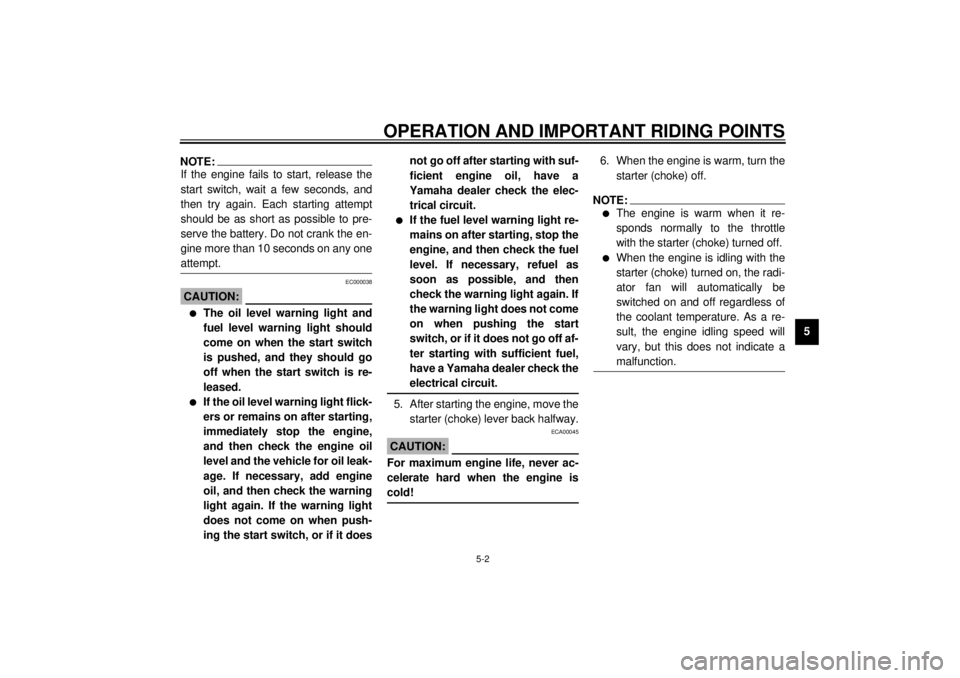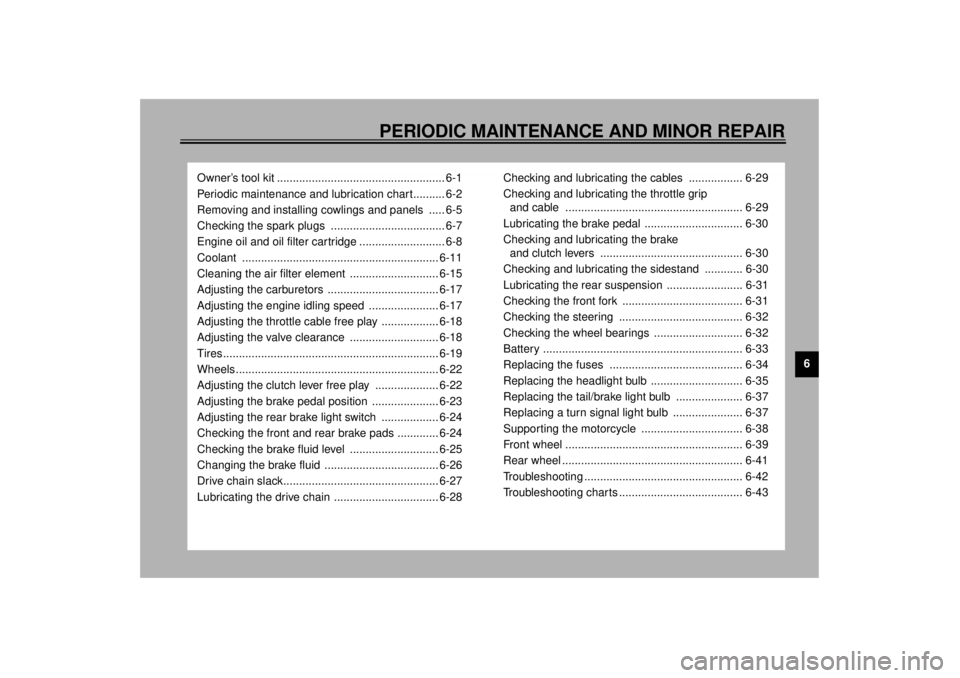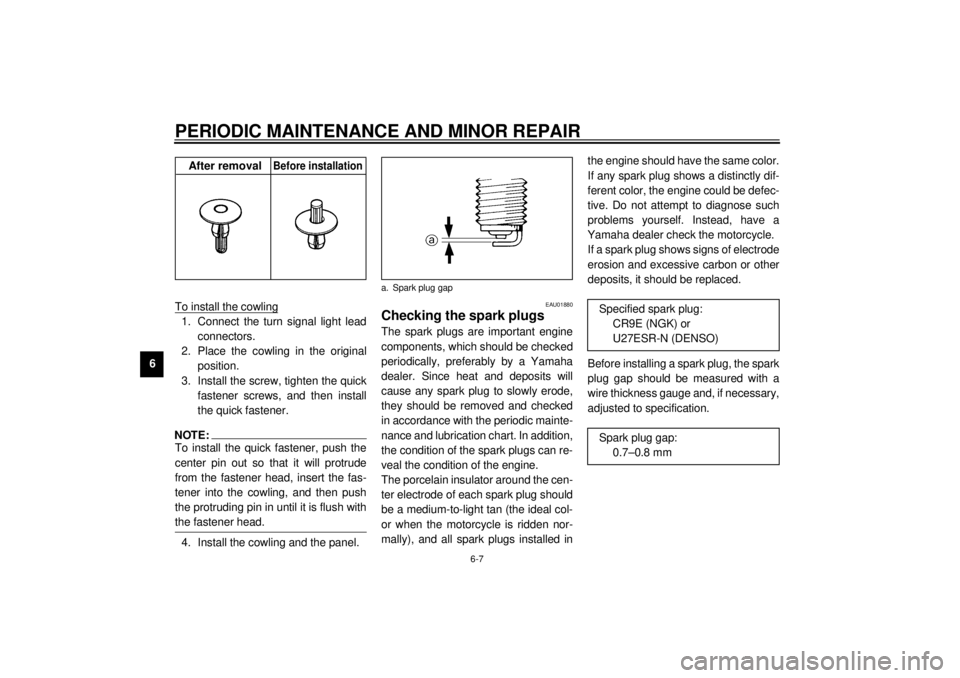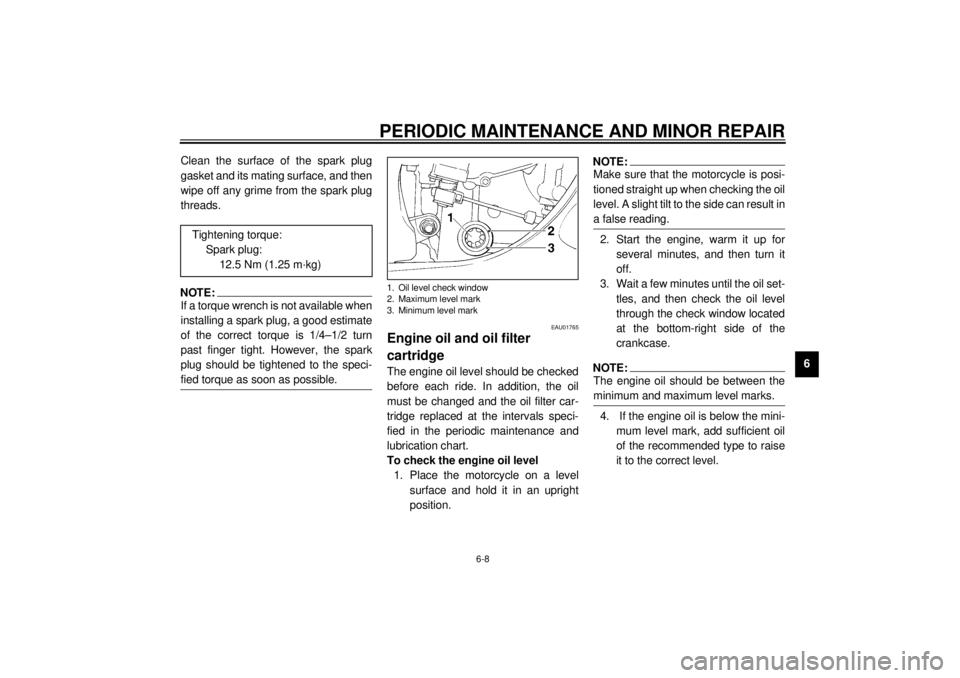check engine light YAMAHA YZF-R1 2000 Owners Manual
[x] Cancel search | Manufacturer: YAMAHA, Model Year: 2000, Model line: YZF-R1, Model: YAMAHA YZF-R1 2000Pages: 115, PDF Size: 12.28 MB
Page 17 of 115

INSTRUMENT AND CONTROL FUNCTIONS
3-2
3
EAU01574
(Parking)
The steering is locked, and the taillights
and auxiliary lights are on, but all other
electrical systems are off. The key can
be removed.
The steering must be locked before the
key can be turned to “ ”.
ECA00043
CAUTION:@ Do not use the parking position for
an extended length of time, other-
wise the battery may discharge. @
EAU00056
Indicator lights
EAU00061
Neutral indicator light “ ”
This indicator light comes on when the
transmission is in the neutral position.
EAU00063
High beam indicator light “ ”
This indicator comes on when the
headlight high beam is used.
EAU00057
Turn signal indicator light “ ”
This indicator light flashes when the
turn signal switch is pushed to the left
or right.
EAU01666
Fuel level warning light “ ”
This warning light comes on when the
fuel level drops below approximately
3.8 L . When this occurs, refuel as soon
as possible.
The electrical circuit of the warning light
can be checked according to the fol-
lowing procedure.
1. Set the engine stop switch to “ ”
and turn the key to “ON”.
2. Shift the transmission into the neu-
tral position or pull the clutch lever.
3. Push the start switch. If the warn-
ing light does not come on while
pushing the start switch, have a
Yamaha dealer check the electri-
cal circuit.
1. Neutral indicator light “ ”
2. High beam indicator light “ ”
3. Turn signal indicator light “ ”
4. Fuel level warning light “ ”
5. Oil level warning light “ ”
E_5jj_Functions.fm Page 2 Wednesday, February 2, 2000 5:17 PM
Page 18 of 115

INSTRUMENT AND CONTROL FUNCTIONS
3-3
3
EAU03155
Oil level warning light “ ”
This warning light comes on when the
engine oil level is low.
The electrical circuit of the warning light
can be checked according to the fol-
lowing procedure.
1. Set the engine stop switch to “ ”
and turn the key to “ON”.
2. Shift the transmission into the neu-
tral position or pull the clutch lever.3. Push the start switch. If the warn-
ing light does not come on while
pushing the start switch, have a
Yamaha dealer check the electri-
cal circuit.
NOTE:@ l
Even if the oil level is sufficient, the
warning light may flicker when
riding on a slope or during sudden
acceleration or deceleration, but
this is not a malfunction.
l
This model is equipped with a self-
diagnosis device for the oil level
warning light circuit. (See page 3-8
for an explanation of the self-diag-
nosis device.)
@
EAU03156
Coolant temperature warning light
“”
This warning light comes on when the
engine overheats. When this occurs,
stop the engine immediately and allow
the engine to cool.
The electrical circuit of the warning light
can be checked according to the fol-
lowing procedure.
1. Set the engine stop switch to “ ”
and turn the key to “ON”.
2. Shift the transmission into the neu-
tral position or pull the clutch lever.
1. Neutral indicator light “ ”
2. High beam indicator light “ ”
3. Turn signal indicator light “ ”
4. Fuel level warning light “ ”
5. Oil level warning light “ ”
1. Coolant temperature gauge
2. Coolant temperature warning light “ ”
E_5jj_Functions.fm Page 3 Wednesday, February 2, 2000 5:17 PM
Page 19 of 115

INSTRUMENT AND CONTROL FUNCTIONS
3-4
3 3. Push the start switch. If the warn-
ing light does not come on while
pushing the start switch, have a
Yamaha dealer check the electri-
cal circuit.
EC000002
CAUTION:@ Do not operate the engine if it is
overheated. @
E_5jj_Functions.fm Page 4 Wednesday, February 2, 2000 5:17 PM
Page 23 of 115

INSTRUMENT AND CONTROL FUNCTIONS
3-8
3 Use the chart below to identify the
faulty electrical circuit.
CB-26EIf the tachometer displays such an er-
ror code, note the circuit-specific num-
ber of r/min, and then have a Yamaha
dealer check the motorcycle.
EC000004
CAUTION:@ When the tachometer displays an
error code, the motorcycle should
be checked as soon as possible in
order to avoid engine damage. @
This model is also equipped with a self-
diagnosis device for the oil level warn-
ing light circuit. If the oil level warning
light circuit is defective, the following
cycle will be repeated until the malfunc-
tion is corrected: The warning light will
flash eight times, then go off for three
seconds. If this occurs, have a Yamaha
dealer check the motorcycle.
EAU00109
Anti-theft alarm (optional)This motorcycle can be equipped with
an optional anti-theft alarm by a
Yamaha dealer. Contact a Yamaha
dealer for more information.
Specific r/min
Faulty electrical circuit
3,000 r/min
Throttle position sensor
4,000 r/min
Speed sensor
7,000 r/min
EXUP system
E_5jj_Functions.fm Page 8 Wednesday, February 2, 2000 5:17 PM
Page 46 of 115

5-1
5
EAU00372
5-OPERATION AND IMPORTANT RIDING POINTS
EAU00373
WARNING
@ l
Become thoroughly familiar
with all operating controls and
their functions before riding.
Consult a Yamaha dealer re-
garding any control or function
that you do not thoroughly un-
derstand.
l
Never start the engine or oper-
ate it in a closed area for any
length of time. Exhaust fumes
are poisonous, and inhaling
them can cause loss of con-
sciousness and death within a
short time. Always make sure
that there is adequate ventila-
tion.
l
Before starting out, make sure
that the sidestand is up. If the
sidestand is not raised com-
pletely, it could contact the
ground and distract the opera-
tor, resulting in a possible loss
of control.
@
EAU03160
Starting a cold engine In order for the ignition circuit cut-off
system to enable starting, one of the
following conditions must be met:l
The transmission is in the neutral
position.
l
The transmission is in gear with
the clutch lever pulled and the
sidestand up.
EW000054
WARNING
@ l
Before starting the engine,
check the function of the igni-
tion circuit cut-off system ac-
cording to the procedure
described on page 3-24.
l
Never ride with the sidestand
down.
@1. Turn the key to “ON” and make
sure that the engine stop switch is
set to “ ”.
EC000035
CAUTION:@ If the fuel level warning light comes
on, check the fuel level, and, if nec-
essary, refuel as soon as possible. @2. Shift the transmission into the neu-
tral position.NOTE:@ When the transmission is in the neutral
position, the neutral indicator light
should be on, otherwise have a
Yamaha dealer check the electrical cir-
cuit. @3. Turn the starter (choke) on and
completely close the throttle. (See
page 3-13 for starter (choke) oper-
ation.)
4. Start the engine by pushing the
start switch.
E_5jj_Operation.fm Page 1 Wednesday, February 2, 2000 5:18 PM
Page 47 of 115

OPERATION AND IMPORTANT RIDING POINTS
5-2
5
NOTE:@ If the engine fails to start, release the
start switch, wait a few seconds, and
then try again. Each starting attempt
should be as short as possible to pre-
serve the battery. Do not crank the en-
gine more than 10 seconds on any one
attempt. @
EC000038
CAUTION:@ l
The oil level warning light and
fuel level warning light should
come on when the start switch
is pushed, and they should go
off when the start switch is re-
leased.
l
If the oil level warning light flick-
ers or remains on after starting,
immediately stop the engine,
and then check the engine oil
level and the vehicle for oil leak-
age. If necessary, add engine
oil, and then check the warning
light again. If the warning light
does not come on when push-
ing the start switch, or if it doesnot go off after starting with suf-
ficient engine oil, have a
Yamaha dealer check the elec-
trical circuit.
l
If the fuel level warning light re-
mains on after starting, stop the
engine, and then check the fuel
level. If necessary, refuel as
soon as possible, and then
check the warning light again. If
the warning light does not come
on when pushing the start
switch, or if it does not go off af-
ter starting with sufficient fuel,
have a Yamaha dealer check the
electrical circuit.
@5. After starting the engine, move the
starter (choke) lever back halfway.
ECA00045
CAUTION:@ For maximum engine life, never ac-
celerate hard when the engine is
cold! @
6. When the engine is warm, turn the
starter (choke) off.NOTE:@ l
The engine is warm when it re-
sponds normally to the throttle
with the starter (choke) turned off.
l
When the engine is idling with the
starter (choke) turned on, the radi-
ator fan will automatically be
switched on and off regardless of
the coolant temperature. As a re-
sult, the engine idling speed will
vary, but this does not indicate a
malfunction.
@
E_5jj_Operation.fm Page 2 Wednesday, February 2, 2000 5:18 PM
Page 51 of 115

6
PERIODIC MAINTENANCE AND MINOR REPAIR
Owner’s tool kit ..................................................... 6-1
Periodic maintenance and lubrication chart.......... 6-2
Removing and installing cowlings and panels ..... 6-5
Checking the spark plugs .................................... 6-7
Engine oil and oil filter cartridge ........................... 6-8
Coolant .............................................................. 6-11
Cleaning the air filter element ............................ 6-15
Adjusting the carburetors ................................... 6-17
Adjusting the engine idling speed ...................... 6-17
Adjusting the throttle cable free play .................. 6-18
Adjusting the valve clearance ............................ 6-18
Tires .................................................................... 6-19
Wheels ................................................................ 6-22
Adjusting the clutch lever free play .................... 6-22
Adjusting the brake pedal position ..................... 6-23
Adjusting the rear brake light switch .................. 6-24
Checking the front and rear brake pads ............. 6-24
Checking the brake fluid level ............................ 6-25
Changing the brake fluid .................................... 6-26
Drive chain slack................................................. 6-27
Lubricating the drive chain ................................. 6-28Checking and lubricating the cables ................. 6-29
Checking and lubricating the throttle grip
and cable ........................................................ 6-29
Lubricating the brake pedal ............................... 6-30
Checking and lubricating the brake
and clutch levers ............................................. 6-30
Checking and lubricating the sidestand ............ 6-30
Lubricating the rear suspension ........................ 6-31
Checking the front fork ...................................... 6-31
Checking the steering ....................................... 6-32
Checking the wheel bearings ............................ 6-32
Battery ............................................................... 6-33
Replacing the fuses .......................................... 6-34
Replacing the headlight bulb ............................. 6-35
Replacing the tail/brake light bulb ..................... 6-37
Replacing a turn signal light bulb ...................... 6-37
Supporting the motorcycle ................................ 6-38
Front wheel ........................................................ 6-39
Rear wheel ......................................................... 6-41
Troubleshooting .................................................. 6-42
Troubleshooting charts ....................................... 6-43
E_5jj_PeriodicTOC.fm Page 1 Wednesday, February 2, 2000 5:18 PM
Page 55 of 115

PERIODIC MAINTENANCE AND MINOR REPAIR
6-4
6
* Since these items require special tools, data and technical skills, have a Yamaha dealer perform the service.
EAU03126
NOTE:@ l
The annual checks must be performed once a year, regardless of the mileage traveled.
l
The air filter needs more frequent service if you are riding in unusually wet or dusty areas.
l
Hydraulic brake service
• Regularly check and, if necessary, correct the brake fluid level.
• Every two years replace the internal components of the brake master cylinder and caliper, and change the brake fluid.
• Replace the brake hoses every four years and if cracked or damaged.
@24 Engine oil filter cartridge• Replace.ÖÖ
25
*Cooling system• Check coolant level and vehicle for coolant leakage.
• Correct if necessary.ÖÖ
• Change coolant.Ö
26*Front and rear brake
switches• Check operation.
• Correct accordingly.ÖÖ Ö
27 Moving parts and cables• Lubricate if necessary.ÖÖ
28*Air induction system• Check the air cut valve and reed valve for damage.
• Replace the entire air induction system if necessary.Ö
29*Muffler and exhaust pipe• Check the screw clamp for looseness.
• Tighten if necessary.ÖÖ
30*Lights, signals and
switches• Check operation.
• Correct if necessary.
• Adjust headlight beam if necessary.ÖÖ Ö NO. ITEM CHECKS AND MAINTENANCE JOBSInitial
1,000 kmEvery Every
Annual
check
10,000 km 20,000 km
E_5jj_Periodic.fm Page 4 Wednesday, February 2, 2000 5:18 PM
Page 58 of 115

PERIODIC MAINTENANCE AND MINOR REPAIR
6-7
6To install the cowling
1. Connect the turn signal light lead
connectors.
2. Place the cowling in the original
position.
3. Install the screw, tighten the quick
fastener screws, and then install
the quick fastener.NOTE:@ To install the quick fastener, push the
center pin out so that it will protrude
from the fastener head, insert the fas-
tener into the cowling, and then push
the protruding pin in until it is flush with
the fastener head. @4. Install the cowling and the panel.
EAU01880
Checking the spark plugs The spark plugs are important engine
components, which should be checked
periodically, preferably by a Yamaha
dealer. Since heat and deposits will
cause any spark plug to slowly erode,
they should be removed and checked
in accordance with the periodic mainte-
nance and lubrication chart. In addition,
the condition of the spark plugs can re-
veal the condition of the engine.
The porcelain insulator around the cen-
ter electrode of each spark plug should
be a medium-to-light tan (the ideal col-
or when the motorcycle is ridden nor-
mally), and all spark plugs installed inthe engine should have the same color.
If any spark plug shows a distinctly dif-
ferent color, the engine could be defec-
tive. Do not attempt to diagnose such
problems yourself. Instead, have a
Yamaha dealer check the motorcycle.
If a spark plug shows signs of electrode
erosion and excessive carbon or other
deposits, it should be replaced.
Before installing a spark plug, the spark
plug gap should be measured with a
wire thickness gauge and, if necessary,
adjusted to specification.
After removal
Before installation
a. Spark plug gap
Specified spark plug:
CR9E (NGK) or
U27ESR-N (DENSO)
Spark plug gap:
0.7–0.8 mm
E_5jj_Periodic.fm Page 7 Wednesday, February 2, 2000 5:18 PM
Page 59 of 115

PERIODIC MAINTENANCE AND MINOR REPAIR
6-8
6 Clean the surface of the spark plug
gasket and its mating surface, and then
wipe off any grime from the spark plug
threads.
NOTE:@ If a torque wrench is not available when
installing a spark plug, a good estimate
of the correct torque is 1/4–1/2 turn
past finger tight. However, the spark
plug should be tightened to the speci-
fied torque as soon as possible. @
EAU01765
Engine oil and oil filter
cartridgeThe engine oil level should be checked
before each ride. In addition, the oil
must be changed and the oil filter car-
tridge replaced at the intervals speci-
fied in the periodic maintenance and
lubrication chart.
To check the engine oil level
1. Place the motorcycle on a level
surface and hold it in an upright
position.
NOTE:@ Make sure that the motorcycle is posi-
tioned straight up when checking the oil
level. A slight tilt to the side can result in
a false reading. @2. Start the engine, warm it up for
several minutes, and then turn it
off.
3. Wait a few minutes until the oil set-
tles, and then check the oil level
through the check window located
at the bottom-right side of the
crankcase.NOTE:@ The engine oil should be between the
minimum and maximum level marks. @4. If the engine oil is below the mini-
mum level mark, add sufficient oil
of the recommended type to raise
it to the correct level. Tightening torque:
Spark plug:
12.5 Nm (1.25 m·kg)
1. Oil level check window
2. Maximum level mark
3. Minimum level mark
E_5jj_Periodic.fm Page 8 Wednesday, February 2, 2000 5:18 PM